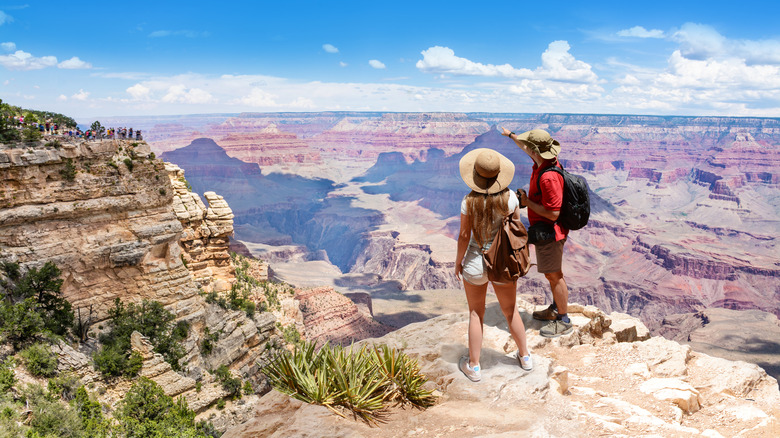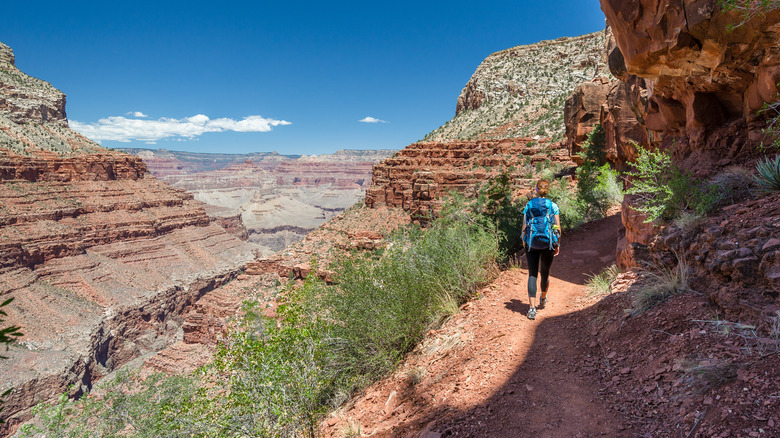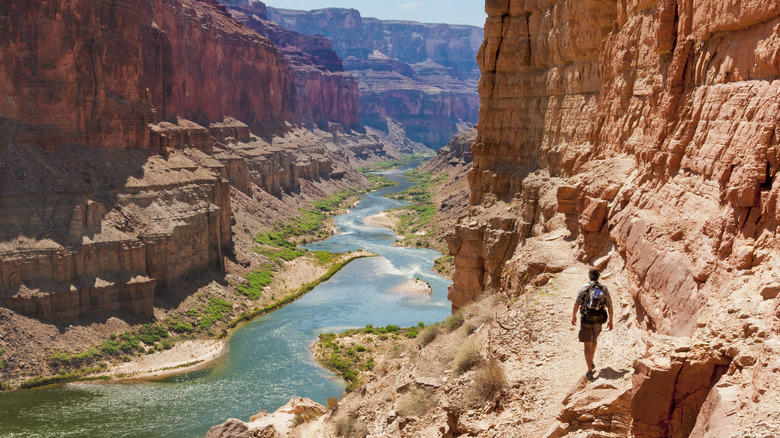What It Means To Be A 'One Percenter' On Your Trip To The Grand Canyon
The Grand Canyon receives nearly 5 million annual visitors, but only a fraction of them will ever hike it, much less cross it. We're talking from top to bottom and back up again. When looking out over the canyon, you might be more preoccupied with its amazing natural beauty or the thought of how scary it would be to fall into it. There's a third option here; hiking the canyon from rim to rim. If you've done it or are thinking about it, welcome to the world of the one-percenters.
Outside the canyon — whether you're talking about the upper crust of society hoarding wealth or a minority of motorcycle clubs breaking the law — the one-percenter term can have a negative connotation. Not so with the elite subset of travelers who make a rim-to-rim hike of the Grand Canyon. For them, "one-percenter" is a hard-won badge of honor.
Descending into the canyon and reemerging on the other side is a difficult hike that's not for amateurs. Technically, fewer than one percent of people do it (hence the name). With enough training, however, it is possible, even for nonagenarians. In 2024, Guinness World Records announced a 92-year-old as the oldest known person to hike the canyon from rim to rim on foot. This was mere months after a 55-year-old died while attempting to make a similar hike in just one day. Two other hikers died in the canyon the same year, so it's not to be underestimated.
From the North Rim to the South Rim
The South Rim of the Grand Canyon is where the National Park Service operates its free shuttle bus service. It is open year-round and is where you'll find the Grand Canyon Village, along with other tourist-friendly museums, visitor centers, and lookouts like the Desert View Watchtower. As a one-percenter, however, you may start your hike on the lesser-visited North Rim. It closes during the winter, leaving May to October as the best time to visit.
The Guinness World Record holder, 92-year-old Alfredo Aliaga, began his hike on the North Rim. It's worth pointing out that he led a very active lifestyle, where he was used to walking three hours a day, making 2,000-mile bike rides, and hiking in destinations like Mount Everest (per USA Today). When you hit the North Kaibab Trail — the only access point on the North Rim — you'll be hiking down 6,000 feet to the floor of the Grand Canyon. At the bottom, you'll link up with the Bright Angel Trail and hike back up another 4,500 feet to reach the South Rim.
It's a 24-mile hike that the National Park Foundation classifies as strenuous. As part of your general training and planning, you'll need to secure a place to stay in the canyon. Doing the Arizona equivalent of "bullet climbing" (hiking the canyon all in one go, without proper rest) is no more advisable here than it would be on Mount Fuji.
A long window of preparation
The cabins of Phantom Lodge, the only permanent lodging below the Grand Canyon's rim, have a lottery system for reservations. You can enter to win a stay there 15 months beforehand or try for the leftover slots when they open two months later. Pitch-and-stay campgrounds like Bright Angel, Cottonwood, and Havasupai Gardens (formerly known as Indian Garden) all require backcountry permits. There's also an early access lottery for these, which begins four months ahead of time, with the remaining availability opening up three months prior.
Even with training, a rim-to-rim hike of the Grand Canyon can be challenging on one's body, especially if you do it during the height of summer, when you could be baking in 120 degrees Fahrenheit heat along the trail. In addition to any camping gear you might require, you'll need water, snacks, first-aid supplies, and proper clothing to protect yourself against the sun and temperature changes. In short, a lot needs to be readied well in advance for this once-in-a-lifetime hike.
If preparing to become a Grand Canyon one-percenter sounds too impractical for your life situation, you can always settle for the next best thing: being a five-percenter. Since only 5% of visitors venture below the rim at all, there's no shame in hiking part of the way or even just taking a mule ride. The ultimate point is to venture off the beaten path and experience a different side of the most-filmed national park in the U.S.


